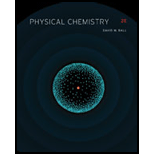
Concept explainers
Interpretation:
The reaction that can provide sufficient energy to do required work is to be identified.
Concept Introduction:
Standard Gibbs free energy of a reaction is used check whether the reaction is spontaneous or not. If the value of
Answer to Problem 8.15E
Correct answer:
The correct option is (b) and (d).
Explanation of Solution
Reason for correct answer:
(b)
The given chemical equation (b) is represented as,
From Table
The number of moles of electrons transferred in the above reaction is
The above equation is reversed and the value of
From Table
The number of moles of electrons transfer in the above reaction is
The relation between standard Gibbs free energy and standard electrical potential is represented as,
Where,
•
•
•
•
Substitute the values of the standard oxidation potential of
The value
Substitute the values of the standard reduction potential of
The value
The balanced overall electrochemical reaction is obtained when chemical equation (2) is multiplied by
Therefore, the value
The maximum amount of work that can be done by the given chemical reaction (b) is
(d)
The given chemical equation (d) is represented as,
From Table
The above equation is reversed and the value of
The number of moles of electrons transfer in the above reaction is
From Table
The number of moles of electrons transfer in the above reaction is
Substitute the values of the standard oxidation potential of
The value
Substitute the values of the standard reduction potential of
The value
The balanced overall electrochemical reaction is obtained when chemical equation (5) is multiplied by
Therefore, the value
The required work done is
Therefore, the given reaction (b) and (d) can provide enough energy to perform the process.
The correct options are (b) and (d).
Reason for incorrect options:
(a)
The given chemical equation (a) is represented as,
From Table
The number of moles of electrons transfer in the above reaction is
From Table
The number of moles of electrons transfer in the above reaction is
The above equation is reversed and the value of
Substitute the values of the standard reduction potential of
The value
The standard electrical potential of the reaction (7) is
The balanced overall electrochemical reaction is obtained when chemical equation (6) is added in chemical equation (7). The formation of overall balanced chemical equation is represented as,
Therefore, the value
(c)
The given chemical equation (c) is represented as,
From Table
The above equation is reversed and the value of
The chemical equation (7) is reversed and the value of
The number of moles of electrons transfer in the above reaction is
Substitute the values of the standard oxidation potential of
The value
Substitute the values of the standard reduction potential of
The value
The balanced overall electrochemical reaction is obtained when chemical equation (8) is added in chemical equation (9). The formation of overall balanced chemical equation is represented as,
The value
The energy produce by the reaction (a) and (b) is less than the required energy.
Therefore, the option (a) and (c) are incorrect.
The reaction (b) and reaction (d) provides sufficient amount of energy to do required work. Therefore, the option (b) and (d) are correct.
Want to see more full solutions like this?
Chapter 8 Solutions
PHYSICAL CHEMISTRY-STUDENT SOLN.MAN.
- At 90ºC the vapor pressure of ortho-xylene is 20 kPa and that of meta-xylene is 18 kPa. What is the composition of the vapor in equilibrium with a mixture in which the mole fraction of o-xylene is 0.60?arrow_forwardDraw the products of this reduction of a ketone with sodium borohydride. Use a dash or wedge bond to indicate the stereochemistry of substituents on asymmetric centers, where applicableIgnore any inorganic byproducts. 1) NaBH4 2) HCI/H2O Select to Drawarrow_forwardWhy do you think people who live at high altitudes are advised to add salt to water when boiling food like pasta? What mole fraction of NaCl is needed to raise the boiling point of H2O by 3˚C? Does the amount of salt added to water (typically about one teaspoon to four quarts of water) substantially change the boiling point? (Kb (H2O) = 0.51˚C/molal.)arrow_forward
- pls help asaparrow_forwardpls help asaparrow_forward9. Consider the following galvanic cell: Fe (s) | Fe(NO3)2 (aq) || Sn(NO3)2 (aq) | Sn (s) a. Write an equation for the half reactions occurring at the anode and cathode. b. Calculate the standard cell potential Show all of your work. c. Draw and label the galvanic cell, including the anode and cathode, direction of electron flow, and direction of ion migration.arrow_forward
- pls help asaparrow_forward11. Use the equation below to answer the following questions: 2 Al(s) + 3 Cd(NO3)2 (aq) → 2 Al(NO3)3 (aq) + 3 Cd(s) a. What is the net ionic equation for the reaction? b. Which species is a spectator ion in this reaction? Define a spectator ion. c. Identify the oxidizing agent and the reducing agent.arrow_forwardpls help asaparrow_forward
 ChemistryChemistryISBN:9781305957404Author:Steven S. Zumdahl, Susan A. Zumdahl, Donald J. DeCostePublisher:Cengage Learning
ChemistryChemistryISBN:9781305957404Author:Steven S. Zumdahl, Susan A. Zumdahl, Donald J. DeCostePublisher:Cengage Learning Chemistry: An Atoms First ApproachChemistryISBN:9781305079243Author:Steven S. Zumdahl, Susan A. ZumdahlPublisher:Cengage Learning
Chemistry: An Atoms First ApproachChemistryISBN:9781305079243Author:Steven S. Zumdahl, Susan A. ZumdahlPublisher:Cengage Learning
 Chemistry: The Molecular ScienceChemistryISBN:9781285199047Author:John W. Moore, Conrad L. StanitskiPublisher:Cengage Learning
Chemistry: The Molecular ScienceChemistryISBN:9781285199047Author:John W. Moore, Conrad L. StanitskiPublisher:Cengage Learning General Chemistry - Standalone book (MindTap Cour...ChemistryISBN:9781305580343Author:Steven D. Gammon, Ebbing, Darrell Ebbing, Steven D., Darrell; Gammon, Darrell Ebbing; Steven D. Gammon, Darrell D.; Gammon, Ebbing; Steven D. Gammon; DarrellPublisher:Cengage Learning
General Chemistry - Standalone book (MindTap Cour...ChemistryISBN:9781305580343Author:Steven D. Gammon, Ebbing, Darrell Ebbing, Steven D., Darrell; Gammon, Darrell Ebbing; Steven D. Gammon, Darrell D.; Gammon, Ebbing; Steven D. Gammon; DarrellPublisher:Cengage Learning Chemistry by OpenStax (2015-05-04)ChemistryISBN:9781938168390Author:Klaus Theopold, Richard H Langley, Paul Flowers, William R. Robinson, Mark BlaserPublisher:OpenStax
Chemistry by OpenStax (2015-05-04)ChemistryISBN:9781938168390Author:Klaus Theopold, Richard H Langley, Paul Flowers, William R. Robinson, Mark BlaserPublisher:OpenStax





